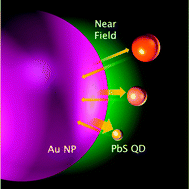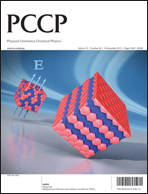Enhancement of PbS quantum dot-sensitized photocurrents using plasmonic gold nanoparticles†
Abstract
For improvement of the conversion efficiency of solar cells, it is important to make effective use of near-infrared light, which accounts for about 40% of sunlight energy. Although solar cells based on quantum dots (QDs) such as PbS have been studied for the use of near-infrared light, their photoabsorption is not necessarily sufficient. In this study, we coupled PbS QD-sensitized solar cells with plasmonic Au nanoparticles (NPs) as light-harvesting antennae. As a result, the photocurrents of the cells were enhanced in the visible and near-infrared regions (500–1200 nm) due to interparticle plasmon coupling of spherical Au NPs. The maximum enhancement factor was 6. We also found that the optimum QD–NP spacing is shorter and that the maximum enhancement factor is higher when smaller QDs are used. These results suggest that a negative effect, quenching via energy transfer from QD to NP, is less significant for smaller PbS QDs.


 Please wait while we load your content...
Please wait while we load your content...